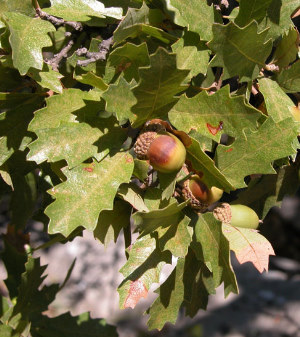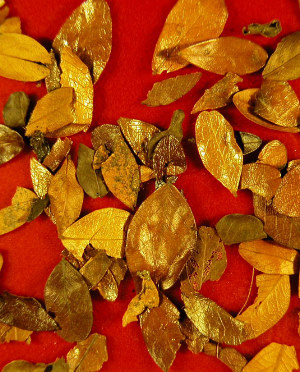Plateau Live Oak, Vasey Shin Oak
Plateau Live Oak (Quercus fusiformis Small)
Vasey Shin Oak (Quercus pungens Liebm. Vaseyana (Buckley) C.H. Muller)
Fagaceae (Beech Family)
Plateau live oak grows into large evergreen shrubs to medium trees with dark almost black bark. The shrubs tend to grow at the heads of canyons and the trees inside canyons or along the lower terraces of intermittent to active streams. Vasey shin oak is a shrub to small tree that seldom exceeds 10 feet in height. It grows in dense shrubby stands at the heads of canyons. Taller trees can be found inside deeper canyons. Oak nuts (acorns) were used as food, oak wood was a favored fuel, and the wood and leaves were used in construction and tool making.
The leathery leaves of the Plateau live oak have a short (3/8-inch) petiole or stalk with elliptical to ovate shape, with entire margin with some leaves sporting an occasional tooth (spinelike point on the margin). The spindle-shaped acorns are small (5/8 to 1-inch long) and light brown. Plateau live oak grows in many canyons in the region.
The shin oak tree is mostly evergreen but can lose its leaves in colder drier winters. The bark is thin and light brown. The leathery, yellow-green leaves are elliptic/oblong about 3/4 inch wide, with wavy toothed margins. Shin oak is widespread throughout the area in rocky canyon settings and growing with goldenball leadtree, plateau live oak, and various acacia species.
Acorns are nuts that consist of a hard pericarp fused to a seedcoat that surrounds the food storage organ, two cotyledons. To process the food stored in the cotyledons the harvesters had to remove the pericarp, a fairly tedious, labor intensive process.
Archeological occurrence. The large quantity of oak leaves, entire acorns, and pericarp fragments recovered from rockshelter deposits in the Pecos River and Devils River areas illustrates that the ancient foragers regularly collected and processed acorns. Oak leaves and whole acorns were recovered from many excavation areas and levels at Hinds Cave. For example, plateau live oak leaves were very common in Middle Archaic deposits of Hinds Cave. Oak wood charcoal is common in both dry rockshelters and open sites in the Lower Pecos Canyonlands, showing that oak this was a favored fuel. Oak was also used to fashion wooden artifacts.
Food and nutrition. Most of the ethnographic records of acorn processing have been recorded from California, where Native Americans relied heavily on the extensive oak woodlands in the region. Native American lifeways persisted after European settlement for several generations, allowing observation and recording of acorn harvests and acorn processing.
Acorns contain fiber, fat, protein, and carbohydrates. Acorn meal, produced by reducing the "meat" or endosperm of the acorn, digests slowly, a critically important food quality for people at risk for Type II diabetes. Along with mesquite meal, acorn meal has a low and slow glycemic response compared to white bread, potatoes, and processed cereals. Acorn meal from commonly utilized California species contains between 5.5-18.0 percent fats, about 60 percent carbohydrates, and 4-6 percent protein, very favorable quantities for plant foods (reported in Bean and Saubel 1972:126).
Acorns contain tannic acid which imparts a bitter taste to the acorn meal. The tannins must be removed by processing, most often accomplished by some form of rinsing or leaching. Live oaks and white oaks have the lowest tannin content, and therefore require less processing (Landrum 1993:205). Although most groups leached acorn meal before consuming it, some groups would eat whole, raw acorns (after shelling them). These were probably species of oaks that had very low tannin content, and both Plateau live oak and vasey shin oak are low in tannins.
The details of acorn processing are presented in many sources and summarized in Gifford (1936) and Jackson (1991). It was a laborious procedure, and it was a woman's task ( Jackson 1991). Implements included mortars and pestles or manos and metates, carrying baskets, sifting baskets, parching trays, leaching baskets, and brushes made of yucca fiber or other plants to clean out the mortars and presumably the metates (Bean and Saubel 1972:127; Jackson 1991:304-305).
Acorns must first be shelled, which involves the removal of the hard, thin pericarp. Results from initial processing, including shelling and pounding, are improved if the acorns are first dried (Weiss 1994:176). The acorns were dried either in the sun or by parching (Smith 1923:66). Peeling was accomplished by either tapping the pericarp with a "nutting stone" or by peeling it with a small chipped stone flake or knife (Jackson 1991:304). Then the endosperm or "meat" must be reduced to meal. Although some sources refer to grinding, presumably with a mano and metate, the most expedient method is to pound the meat in a mortar and pestle. Shallower mortars were used to start the pounding process, and the initial material was sifted through a woven tray and moved to a deeper mortar, according to Jackson (1991). However, Buskirk (1986:175) reports that the Western Apache used a sandstone mano and metate to grind acorns. The Western Apache also ate whole acorns raw or stored whole acorns after drying them in the sun for a few days.
Gifford (1936:87) notes that leaching followed two basic paths. Some groups actually immersed bags of whole acorns in water or buried them in mud. Others pounded the acorn into meal and rinsed the mass in water. In most cases, however, acorn meat was reduced prior to leaching, usually with a bedrock mortar and a stone or wooden pestle. Reducing the acorn meat to meal prior to leaching is an efficient way to release tannin by breaking down plant tissues and cell walls, thereby increasing the surface area exposed to rinsing (Weiss 1994:169).
Methods of leaching varied, but the Cahuilla practiced a typical approach by placing an acorn meal-filled basket in a shallow depression of sand, and pouring water through the meal. The water would pass through the meal, and drain into the sand, washing away the tannins (Bean and Saubel 1972:128). In Mendocino County the Indians placed incense cedar boughs over the meal so that the water would percolate evenly through the mass (Chesnut 1902:337). Groups that leached acorn meal included the Southern/Santa Ysabel Diegeño, the Paipi, Kiliwa, and the Tipai of northern Baja (Hedges and Beresford 1986; Spier 1923; Weiss 1994).
The consistency of the meal dictated the product made from it. Acorn bread was made from fine meal. More coarsely ground meal would be used to make mush or gruels. The coarsely ground meal swells considerably as it takes on more water during the cooking process (Bean and Saubel 1972:128). Interestingly, the Yuki of Mendocino County added red clay to the dough before baking acorn bread, to sweeten the bread (Chesnut 1902:338). The clay would act to remove more tannins. Further, these breads were baked for 12 hours in earth ovens with rock heating elements. Chesnut (1902:338) describes rocks as heated by a small fire, on which boughs of poison oak, oak, or maple trees are placed. The bread is much sweeter than the meal, probably because of the chemical reduction of the long chain carbohydrates into sugars by hydrolysis.
Medicine. Across North America, many different parts of the oak tree were used for medicinal purposes. As with the examples of food processing, there are no references to either plateau live oak or shin oak, primarily because these trees did not grow in the regions where observers recorded the uses of plants. Unlike the acorns recovered from numerous archeological sites along the Edwards Plateau and Trans-Pecos regions, there is no archeological evidence for the use of oak as a medicine.
However, the following examples are provided as typical use of oak as medicine, with the caveat that we do not know if the oaks growing in the region were used in this manner. Oak galls, produced by a species of wasp, were ground into a powder and mixed in water. The Santa Ysabel Diegeño and the Kawaiisu both utilized this method for eye problems (Hedges and Beresford 1986: Zigmond 1981). The Ramah Navajo used the leaves as an emetic for ceremonial cleansing (Vestal 1952:22). The Miwok used a mixture of the bark for cough medicine (Barret and Gifford 1933:172).
References:
Barrett, Samuel A. and Edward Winslow Gifford
1933 Miwok Material Culture. Bulletin of the Public Museum of the City of Milwaukee 2(4):117-376.
Bean, Lowell J. and Katherine S. Saubel
1972 Temalpakh: Cahuilla Indian Knowledge and Usage of Plants. Malki Museum Press. Morongo Indian Reservation, Banning, California.
Buskirk, Winfred
1986 The Western Apache: Living with the Land Before 1950. University of Oklahoma Press, Norman, Oklahoma.
Chesnut, Victor King
1902 Plants Used by the Indians of Mendocino County, California. Contributions from the U.S. National Herbarium 7(3):295-409.
Gifford, Edward Winslow
1936 Northeastern and Western Yavapai. University of California Publications in American Archaeology and Ethnography. 34:247-354.
Hedges, Ken and Christina Beresford
1986 Santa Ysabel Ethnobotany. San Diego Museum of Man Ethnic Technology Notes 20. San Diego, California.
Jackson, Thomas L.
1991 Pounding Acorn: Women's Production as Social and Economic Focus. In Engendering Archaeology: Women and Prehistory. Edited by Joan M. Gero and Margaret W. Conkey, pp. 301-325. Blackwell, Oxford UK and Cambridge USA.
Landrum, Leslie R.
1993 Fagaceae: Oak Family. Journal of the Arizona-Nevada Academy of Science 27(2):203-214.
Smith, Huron H.
1923 Ethnobotany of the Menomini Indians. Bulletin of the Public Museum of the City of Milwaukee 4:1-174.
Spier, Leslie
1923 Southern Diegeño Customs. University of California Publications in American Archaeology and Ethnology 20:296-358.
Vestal, Paul
1952 Ethnobotany of the Ramah Navaho. Papers of the Peabody Museum of American Archaeology and Ethnology 40 (4). Harvard University, Cambridge, Massachusetts.
Weber, Steven A. and P. David Seaman
1985 Havasupai Habitat: A. F. Whiting's Ethnography of a Traditional Indian Culture. University of Arizona Press, Tucson, Arizona.
Weiss, Audrey Elaine
1994 The Impact of Nutritonal Change on the Emergence of Diabetes in Two Tipai Cochim í Communities in Baja California . Unpublished Dissertation, University of California, Irvine. UMI. Ann Arbor, Michigan.
Zigmond, Maurice L.
1981 Kawaiisu Ethnobotany. University of Utah Press, Salt Lake City, Utah.
![]()


